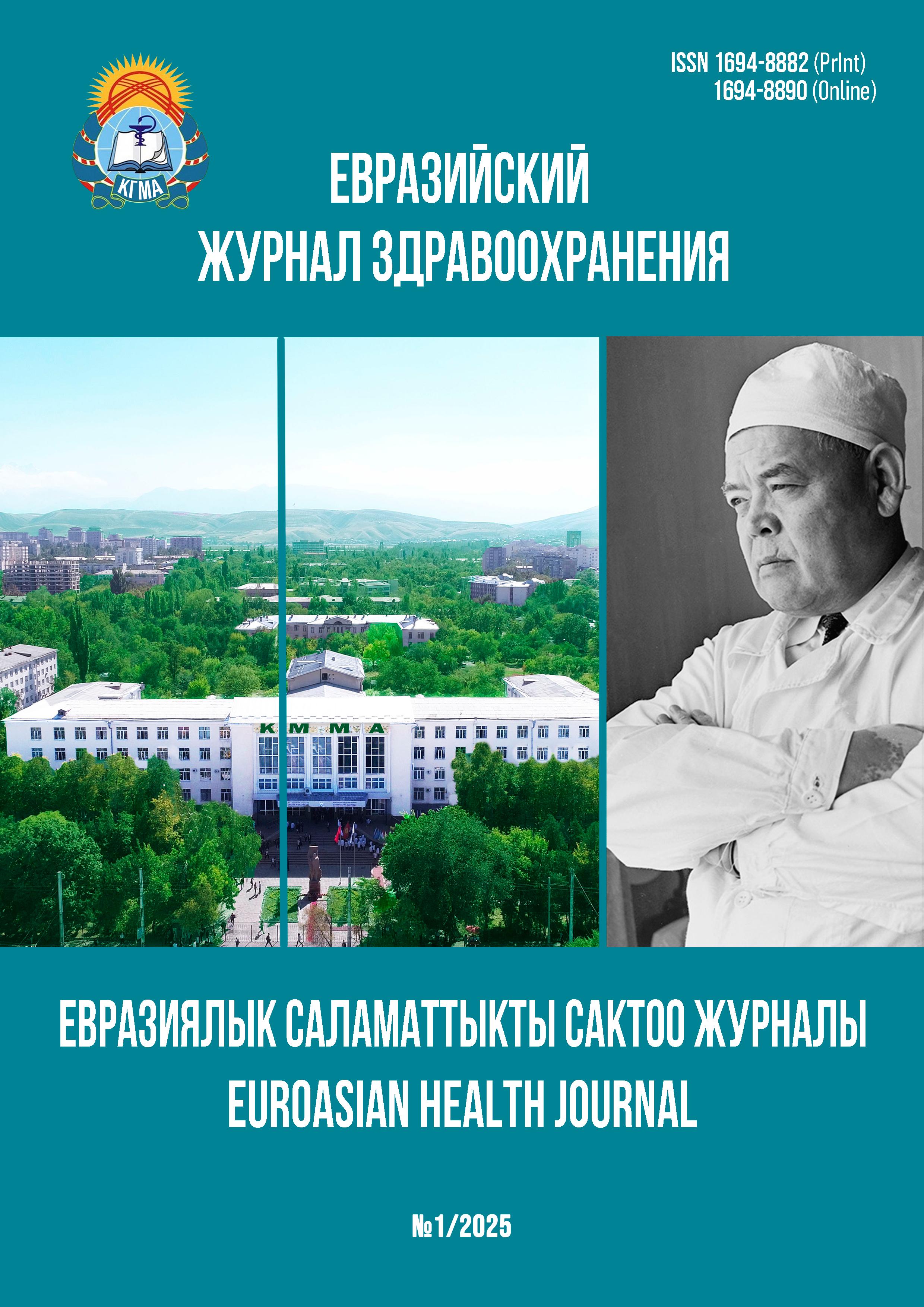ЖЕЛЕЗОДЕФИЦИТНАЯ АНЕМИЯ ПРИ БЕРЕМЕННОСТИ (ОБЗОР ЛИТЕРАТУРЫ)
DOI:
https://doi.org/10.54890/1694-8882-2025-1-28Аннотация
Железодефицитная анемия является глобальной проблемой здравоохранения, особенно затрагивающей беременных женщин. Связь между анемией и плохими исходами для матери, плода и новорожденного в настоящее время хорошо установлена. Анемия все чаще признается как потенциально модифицируемый фактор риска послеродового кровотечения – ведущей причины материнской заболеваемости и смертности. Неблагоприятные последствия для плода и новорожденного включают преждевременные роды, задержку роста и повышенную смертность. Дефицит железа у матери также может быть связан с нейро-когнитивными нарушениями у младенцев. Потребность в железе увеличивается во время беременности и находится под влиянием гепсидина, главного регулятора гомеостаза железа. Недавние достижения, в нашем понимании, системного и плацентарного гомеостаза железа могут улучшить терапевтическую эффективность за счет изменения дозы и частоты перорального приема железа. Будущие исследования должны иметь достаточную мощность для оценки результатов, ориентированных на пациента, результатов экономической эффективности и касающихся беременных женщин.
Ключевые слова:
анемия, беременность, дефицит железа, железоБиблиографические ссылки
1. Vos T, Abajobir AA, Abate KH, Abbafati C, Abbas KM, Abd-Allah F, et al. Global, regional, and national incidence, prevalence, and years lived with disability for 328 diseases and injuries for 195 countries, 1990-2016: a systematic analysis for the Global Burden of Disease Study 2016. Lancet. 2017;390(10100):1211-1259. https://doi.org/10.1016/S0140-6736(17) 32154-2
2. Daru J, Cooper NA, Khan K.S. Systematic review of randomized trials of the effect of iron supplementation on iron stores and oxygen carrying capacity in pregnancy. Acta Obstet Gynecol Scand. 2016;95(3):270-279. https://doi.org/10.1111/ aogs.12812
3. Nair M., Churchill D., Robinson S. Nelson-Piercy C, Stanworth SJ, Knight M. Association between maternal haemoglobin and stillbirth: a cohort study among a multi-ethnic population in England // Br. J. Haematol. 2017;179(5):829-837. https://doi.org/10.1111/bjh.14961
4. Young MF. Maternal anaemia and risk of mortality: a call for action. Lancet Glob Health. 2018;6(5):e479-e480. https://doi.org/10.1016/S2214-109X(18)30185-2
5. Nair M, Choudhury MK, Choudhury SS, Kakoty SD, Sarma UC, Webster P, et al. Association between maternal anaemia and pregnancy outcomes: a cohort study in Assam, India. BMJ Glob Health. 2016;1(1):e000026. https://doi.org/10.1136/ bmjgh-2015-000026
6. Ganz T. Systemic iron homeostasis. Physiol Rev. 2013;93(4):1721–1741. https://doi.org/10.1152/physrev.00008.2013
7. Drakesmith H, Prentice AM. Hepcidin and the iron-infection axis. Science. 2012;338(6108):768-772. https://doi.org/ 10.1126/science.1224577
8. Fisher AL, Nemeth E. Iron homeostasis during pregnancy. Am J Clin Nutr. 2017;106(Suppl 6):1567S–1574S. https://doi.org/10.3945/ajcn.117.155812
9. Sangkhae V, Fisher AL, Wong S, Koenig MD, Tussing-Humphreys L, Chu A, et al. Effects of maternal iron status on placental and fetal iron homeostasis. J Clin Invest. 2020;130(2):625–640. https://doi.org/10.1172/JCI127341
10. van Santen S, Kroot JJ, Zijderveld G, Wiegerinck ET, Spaanderman ME, Swinkels DW. The iron regulatory hormone hepcidin is decreased in pregnancy: a prospective longitudinal study. Clin Chem Lab Med. 2013; 51(7):1395–1401. https://doi.org/10.1515/cclm-2012-0576
11. Rehu M, Punnonen K, Ostland V, Heinonen S, Westerman M, Pulkki K, et al. Maternal serum hepcidin is low at term and independent of cord blood iron status. Eur J Haematol. 2010;85(4):345–352. https://doi.org/10.1111/j.1600-0609.2010.01479.x
12. Churchill D, Nair M, Stanworth SJ, Knight M. The change in haemoglobin concentration between the first and third trimesters of pregnancy: a population study. BMC Pregnancy Childbirth. 2019;19(1):359. https://doi.org/10.1186/s12884-019-2495-0
13. Daru J, Sobhy S, Pavord S. Revisiting the basis for haemoglobin screening in pregnancy. Curr Opin Obstet Gynecol. 2019;31(6):388-392. https://doi.org/10.1097/ GCO.0000000000000580
14. Butcher A, Richards T, Stanworth SJ, Klein AA. Diagnostic criteria for pre-operative anaemia-time to end sex discrimination. Anaesthesia. 2017;72(7):811-814. https://doi.org/10.1111/anae.13877
15. Pavord S, Daru J, Prasannan N, Robinson S, Stanworth S, Girling J, et al. UK guidelines on the management of iron deficiency in pregnancy. Br J Haematol. 2020;188(6):819–830. https://doi.org/10.1111/bjh.16221
16. Choi JW, Im MW, Pai SH. Serum transferrin receptor concentrations during normal pregnancy. Clin Chem. 2000;46(5):725-727.
17. Vora SM, Messina G, Pavord S. Utility of erythrocyte indices in identifying iron depletion in pregnancy. Obstet Med. 2021;14(1):23-25. https://doi.org/10.1177/ 1753495X19878617
18. Miles LF, Sandhu RN, Grobler AC, Heritier S, Burgess A, Burbury KL, et al. Associations between non-anaemic iron deficiency and outcomes following surgery for colorectal cancer: An exploratory study of outcomes relevant to prospective observational studies. Anaesth Intensive Care. 2019;47(2):152-159. doi:10.1177/ 0310057X19838899
19. Say L, Chou D, Gemmill A, Tunçalp Ö, Moller AB, Daniels J, et al. Global causes of maternal death: a WHO systematic analysis. Lancet Glob Health. 2014;2(6): e323-e333. https://doi.org/10.1016/S2214-109X(14)70227-X
20. Daru J, Zamora J, Fernandez-Felix BM, Vogel J, Oladapo OT, Morisaki N, et al. Risk of maternal mortality in women with severe anaemia during pregnancy and post partum: a multilevel analysis. Lancet Glob Health. 2018;6(5):e548–e554. https://doi.org/10.1016/S2214-109X(18)30078-0
21. Briley A, Seed PT, Tydeman G, Ballard H, Waterstone M, Sandall J, et al. Reporting errors, incidence and risk factors for postpartum haemorrhage and progression to severe PPH: a prospective observational study. BJOG. 2014;121(7):876–888. https://doi.org/10.1111/1471-0528.12588
22. Maeda Y, Ogawa K, Morisaki N, Tachibana Y, Horikawa R, Sago H. Association between perinatal anemia and postpartum depression: A prospective cohort study of Japanese women. Int J Gynaecol Obstet. 2020;148(1):48-52. https://doi.org/10.1002/ijgo.12982
23. Haider BA, Olofin I, Wang M, Spiegelman D, Ezzati M, Fawzi WW, et al. Anaemia, prenatal iron use, and risk of adverse pregnancy outcomes: systematic review and meta-analysis. BMJ. 2013;346:f3443. https://doi.org/10.1136/bmj.f3443
24. Alwan NA, Cade JE, McArdle HJ, Greenwood DC, Hayes HE, Simpson NA. Maternal iron status in early pregnancy and birth outcomes: insights from the Baby's Vascular health and Iron in Pregnancy study. Br J Nutr. 2015;113(12):1985-1992. https://doi.org/10.1017/S0007114515001166
25. Pavord S, Myers B, Robinson S, Allard S, Strong J, Oppenheimer C, et al. UK guidelines on the management of iron deficiency in pregnancy. Br J Haematol. 2012;156(5):588–600. https://doi.org/10.1111/j.1365-2141.2011.09012.x
26. Тажибаева У.Ж., Мусакеев А.О., Маматов С.М., Арстанбекова М.А., Иманалиева Ф.Э., Эсенгелди кызы А. Распространенность анемии у госпитализированных пациентов пожилого и старческого возраста Кыргызской Республики. Клиническая геронтология. 2023;29(9-10):22-28. https//doi.org/ 10.26347/1607-2499202309-10022-028
27. Тажибаева У.Ж., Арстанбекова М.А., Мусакеев А.О., Нартаева А.К., Иманалиева Ф.Э., Маматов С.М. Патофизиологические аспекты и лечение дефицита железа у пожилых людей (обзор литературы). Вестник КГМА имени И.К. Ахунбаева. 2023;2:65-72. https://doi.org/10.54890/1694-6405_2023_2_65







